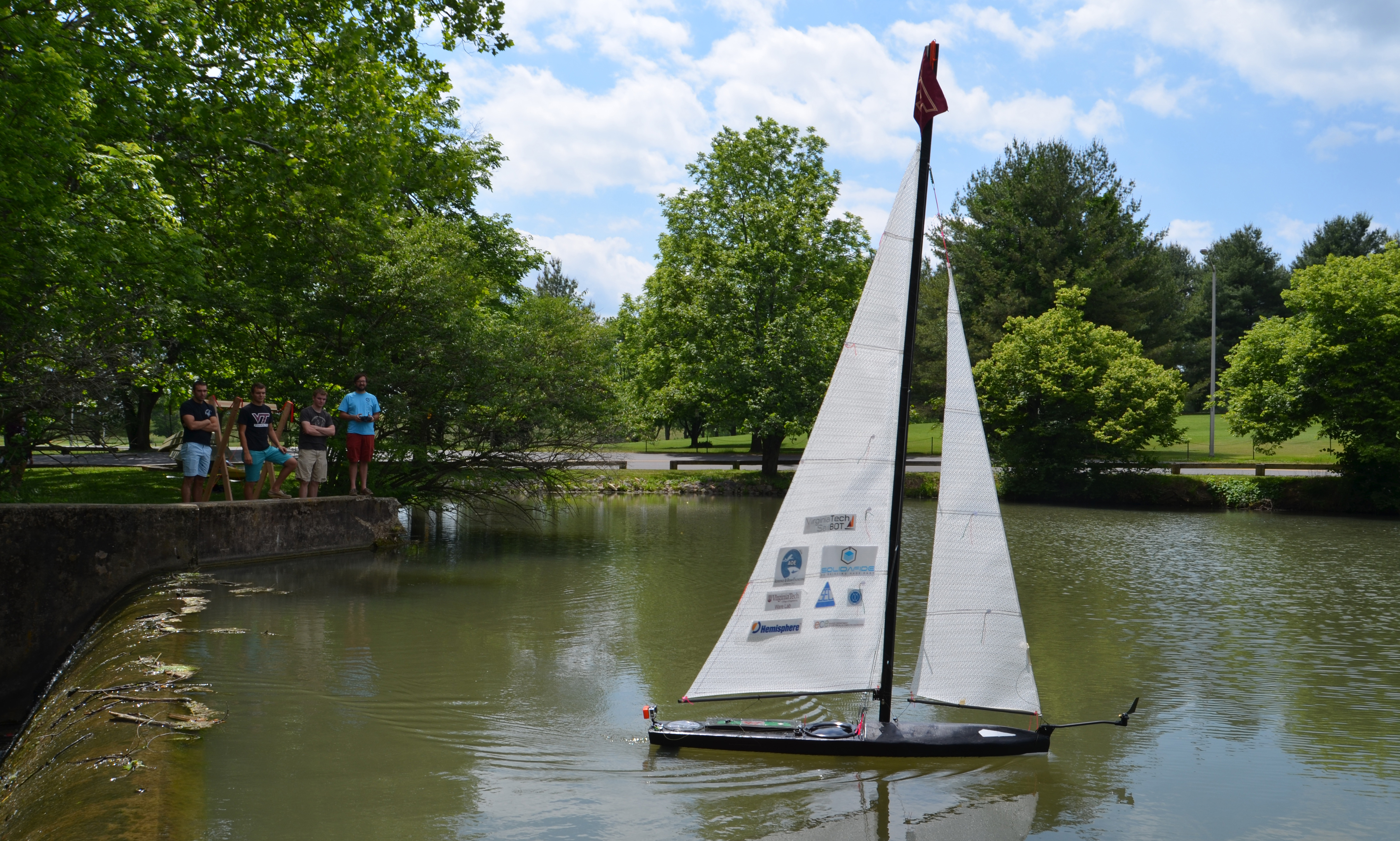College of Engineering team to debut at San Francisco-set autonomous sailboat regatta

A team of Virginia Tech engineering students will race in the 8th annual SailBot 2014 International Robotic Sailing Regatta, a competition dedicated to building unmanned, autonomous miniature sailboats able to operate with limited to no human control.
The June 7-13 event in San Francisco marks Virginia Tech’s debut in the competition, pitting Hokie students against more than a dozen schools and institutions, including founding members Queens University and the University of British Columbia, as well as the U.S. Naval Academy and a team from England.
The Virginia Tech SailBOT team includes roughly 40 students from across the College of Engineering, including the departments of aerospace and ocean engineering, mechanical engineering, engineering and science mechanics, and electrical and computer engineering. Students selected the competition, designed and built the boat from scratch at the Joseph F. Ware Jr. Advanced Engineering, and have tested it at Duck Pond.
The craft shipped to California earlier this week, and four students will attend the race.
The regalia tasks competitors with a traditional sailing race, station keeping, navigational accuracy, and the overall craft presentation. Among the event rules: Craft can be no longer than 2 meters.
The sailboat –black, 6.5 foot in length and lightweight, with a white sail atop –- project started in spring 2013 with an interest meeting, the brainchild of the Virginia Tech Society of Naval Architects and Marine Engineers student organization. The group wanted a surface ship team for ocean engineering students to balance the underwater Human Powered Submarine team, a long-time staple of the Ware Lab, said team commodore Thomas Shea III of Crofton, Maryland.
“A few students did some research, and we felt this was our best and most exciting option since sailing/sailboats design is not covered in our ocean engineering course work, it would be an exciting and great learning experience,” said Shea, who graduated in May with a bachelor’s degree in aerospace and ocean engineering and is an avid boating hobbyist.
The team designed the boat during the fall 2013 semester, with initial guidance from the U.S. Naval Academy. A miniature craft operating autonomously and radio control, the boat need not meet the standards of a regular sailboat: The craft’s body can rest closer to the water, for instance, but – key to running the boat – the craft had to be watertight to prevent electronics from shorting out, said Shea.
Designs set, physical building of the boat began spring 2014, starting with a wood-based plug that was then covered in a fiberglass mold. From there, a carbon fiber body was built, with a foam sandwich-like center, making a tough, lightweight body. A tool to vacuum seal the cross-stitch carbon fiber body was borrowed from the Human Powered Submarine team.
Andrew Barnes of Raleigh, North Carolina, and also newly graduated with a bachelor’s degree in aerospace and ocean engineering, led the hull build effort. Barnes already had some experience. He built his own 10-foot skee craft from a kit while in high school through the summer after his freshman year at Virginia Tech. He says he was inspired to take on the self-build project after watching “Indiana Jones and the Last Crusade,” with its meandering boat chase that takes place in Venice, Italy.
“I thought I would build a boat if I cannot buy one,” said Barnes. He still operates the boat at a lake nearby his parents’ house, as well as closer to campus at Claytor Lake in Pulaski County. In July, he starts work at Norfolk (Virginia) Naval Shipyard. He already is planning to build a new, larger boat in the near future.
Among the challenges during the build and upcoming race, according to Shea: Electronics power management that can autonomously run the sail winch, rudder servo, and communications with the remote pilot for a 10-kilometer bay race that is expected to exceed six hours. The boat’s guidance is GPS based, and will automatically upload best course plots to the craft’s computers during the course race.
Shea looks forward more to learning at the regatta in San Francisco than racing. “The schools that have been doing this for six or seven years, we’ll definitely learn something from them,” he said. This year’s SailBOT team will be the first of many, Shea said, adding that a team for next year already is in place and plans for a catamaran vessel are in the team’s future. Added Barnes, “I’m not expecting us to win everything. I just want us to finish and complete all of our courses.”
Serving as team faculty advisors are Wayne Neu, associate professor of aerospace and ocean engineering, and Dan Stilwell, professor of electrical and computer engineering and a member of Virginia Tech’s Autonomous Systems and Controls Laboratory. Neu advised on building of the hull and keel. Advising on electrical control components, Stillwell previously worked on an autonomous watercraft for the U.S. Navy that would serve as a robotic “scout” on rivers, and also works with autonomous mini-submarines.
“This is the first year that our team has really been in existence at all and they have done a tremendous job to put together a boat,” said Neu. “Not only one where they construct everything mechanically and the hull design and such, but there’s a whole electrical team as well doing the controls. … It’s been quite a yeoman’s effort to put together an entry for this year’s competition all in one year.”




